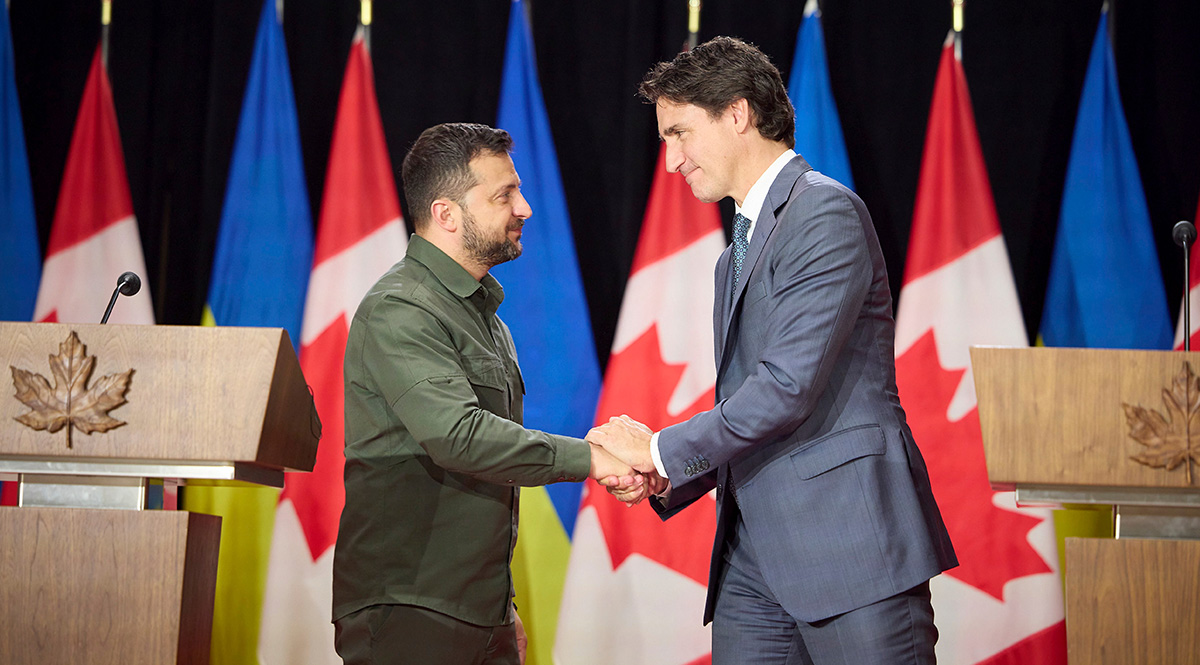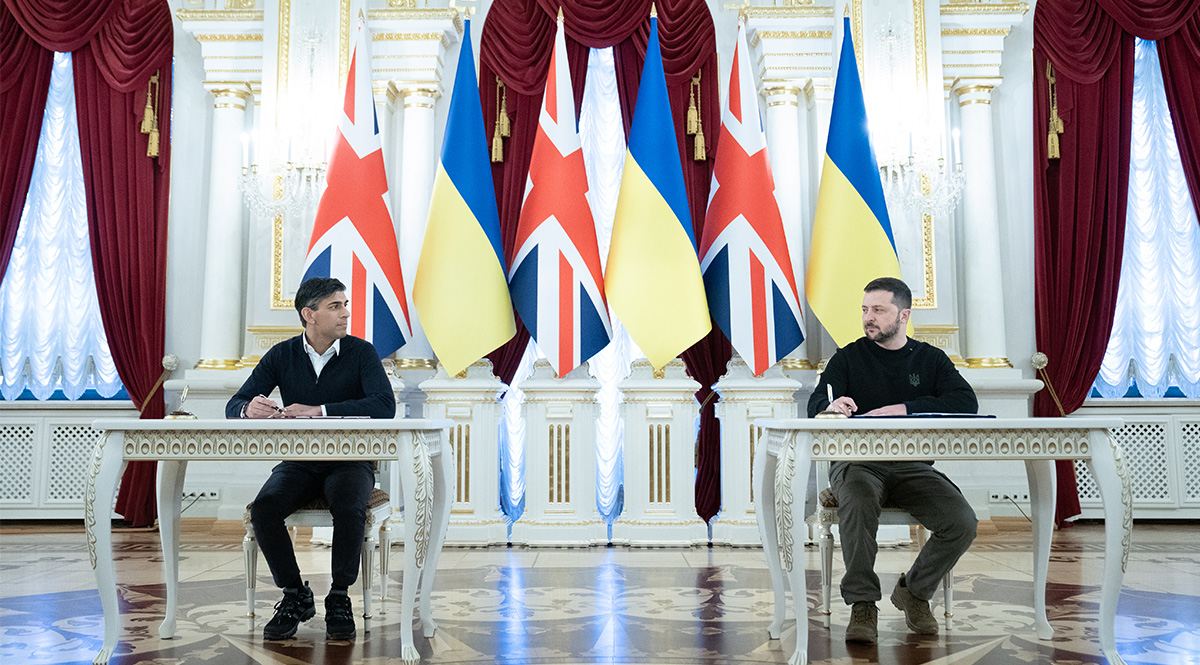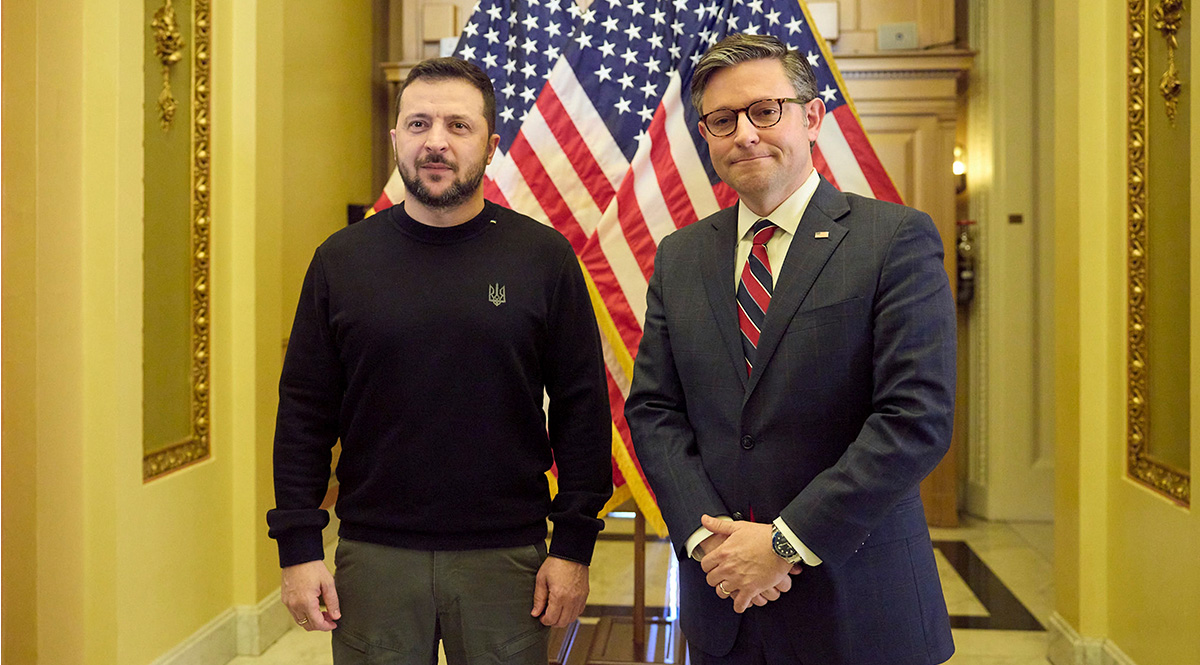Canada Seeking New Forms of Assistance to Ukraine
Challenges related to weapons types and arms production for Canada’s Armed Forces, as well as a growing internal political debate, means that further aid to Ukraine will likely decrease over the next several years. Canada will likely compensate for this by modifying its strategy towards Ukraine to long-term engagement while increasing its involvement in NATO.
 Ukraine Presidency/Ukrainian Pre / Zuma Press / Forum
Ukraine Presidency/Ukrainian Pre / Zuma Press / Forum
In January, Canada presented Ukraine with a draft agreement on long-term security cooperation. The negotiations of the document are expected to be finalised within the coming weeks. During the NATO Vilnius Summit in 2023, Canada and other G7 partners pledged extended support for Ukraine and announced plans to sign related agreements. Bilateral understandings aim to strengthen Ukraine’s long-term security perspective.
Political and Strategic Calculations
Support for Ukraine stems from Canada’s political commitment to upholding a rules-based international order. Canadian officials are of the opinion that the stability of the international system, which is under threat from Russia’s aggressive politics, depends on Canada’s national and transatlantic security. Canada’s large, politically active Ukrainian diaspora (about 1.4 million or 4% of the population) also successfully mobilised and exerted pressure on federal and provincial governments (e.g., in Alberta, Manitoba, Ontario, and Saskatchewan) to pledge substantial assistance to Ukraine. Therefore, Canada is determined to strengthen Ukraine’s ability to defend itself against further Russian aggression. It is among the NATO members that support Ukraine’s aspirations for Alliance membership. The long-term military and financial support to the country is intended to provide sufficient security until its accession to the Alliance.
Since the beginning of Russia’s full-scale invasion in 2022, Canada’s federal government has provided direct financial, humanitarian, and military assistance worth $9.5 billion. The Trudeau government is working closely with partners, including the U.S., the UK and the EU, both bilaterally and in multilateral formats (for example, the G7 and UN) to coordinate joint efforts aimed at sanctioning Russia or limiting its financial capabilities to wage war. Canada plans to play an active role in helping create a legal mechanism for turning over seized and forfeited Russian assets to Ukraine.
Military Assistance and Limitations
Since 2022, the Liberal government has provided $2.4 billion worth of lethal and non-lethal aid to Ukraine, which places Canada in the top ten among NATO allies. Canada sent arms and equipment drawn from Canadian Armed Forces (CAF) stocks and delivered heavy weapons like M777 howitzers (4) along with ammunition (40,000 rounds, half of which were obtained from the U.S.), Leopard 2A4 main battle tanks (8), and armoured (208) and combat support (39) vehicles. Moreover, the Conservative Party (CPC) has pushed Trudeau, who wants to forego depleting CAF’s already limited stocks, to transfer more weapons to Ukraine, such as the anti-ship missile (Harpoon, around 25 units) and now outdated military vehicles planned for disposal, including 195 light armoured and 149 armoured reconnaissance vehicles.
Canada is also joining two international coalitions aimed at strengthening Ukraine’s military potential in combat aircraft and heavy armaments. It also plans on working closely with its allies (the U.S., UK, Denmark, and Holland) to provide Ukraine with more air-defence equipment. For this reason, it plans on purchasing and transferring to Ukraine a U.S. surface-to-air missile defence system (NASAMS) worth $406 million.
Limitations in CAF’s capabilities and the challenges of technical modernisation projects are restricting Canada from maintaining armed support for Ukraine at the present level. After transferring elements to Ukraine and assuming an increased risk of conflict between Russia and NATO, Canada will have to strengthen its own potential. The Trudeau government has yet to publish a policy update originally planned for 2022 for the Liberal Party of Canada’s (LPC) outdated national defence strategy from 2017 that would outline CAF’s long-term needs and objectives, including new equipment from the Canadian arms industry. Moreover, replacing CAF donations to Ukraine will likely take years given Canada’s complex defence procurement process and insufficient arms production industry. Since 2022, production of 155 mm artillery rounds for the M777 increased only from 3,000 to 5,000 per month, far below usage in Ukraine.
For this reason, the federal government in its planned budget has allocated a decreasing amount of military support for Ukraine over the next three years (from $816 million in 2023-2024 to $197 million in 2025-2026). Canada will try counterbalancing this with long-term support guarantees for Ukraine, which will appear in the bilateral agreement under negotiation alongside financial support to defend against Russia’s invasion and for postwar reconstruction. In addition, Canada plans on increasing its contribution to NATO’s defence and deterrence policy. More funds will be allocated for Canada’s Operation Reassurance mission in Latvia as part of the Alliance’s enhanced Forward Presence (eFP) mission: $802 million for 2024-2025 and $872 million in 2025-2026. Prime Minister Justin Trudeau already committed to increasing the multinational force that Canada leads to the brigade level (with up to 2,200 Canadian troops stationed by 2026) and deployed a CAF tank squadron (15 Leopard 2 tanks and 130 personnel) to strengthen battle group capabilities in 2023. Strengthening defence and deterrence will increase a shared sense of security in NATO member states while ensuring political cohesion, which is necessary to maintain support to Ukraine in the long-term. The measures also aim to raise Canada’s credibility as a reliable NATO ally.
Domestic Debate on Ukraine
Russia’s full-scale war in Ukraine remains a topic of high interest, with about half of Canadians reporting that they closely follow the situation; however, the public debate has largely shifted to addressing domestic issues, including the increased costs of living. Internal challenges are raising reluctance to continue supporting Ukraine. While 45% support the federal government maintaining the current level of spending for Ukraine, only 12% think it should be increased, and about 30% believe it should decrease. Canadians are more supportive of the federal government providing non-military assistance to Ukraine, for example, increasing sanctions (50%) or seizing Russian assets in Canada (45%), over providing additional lethal aid (32%). In effect, the federal government plans to adjust its policy towards Ukraine.
A key pillar is updating the 2016 Canada-Ukraine Free Trade Agreement (CUFTA). The LPC seeks to tighten several sections, especially on digital trade, government procurement, and anti-corruption measures. Modernising the agreement is seen as a way for the federal government to engage private Canadian businesses in helping postwar Ukraine rebuild key sectors such as agriculture, energy, and infrastructure. Both sides will also agree to promote carbon-pricing and mitigation policies. The climate portion led the CPC to vote against a bill in the House of Commons updating CUFTA in November 2023. The Conservatives express their willingness to continue assisting Ukraine, yet recent polls show that a bare majority of CPC voters (51%) disagree with Canada’s policy of support.
Conclusions and Perspectives
Like in the United States and other countries, further military aid for Ukraine is being questioned by some Canadians. Canada will decrease the scale of its support while compensating for it in key areas related to Ukraine’s long-term security—ensuring alongside other allies the vital capabilities necessary to defend against new Russian offensives, rebuilding Ukraine’s economy, and supporting Ukraine’s integration into NATO and the EU. Decreasing the scale of armed support to Ukraine and at the same time increasing resources aimed at strengthening the NATO battlegroup in Latvia is meant to demonstrate Canada’s engagement in deterring Russia and defending allies in Central and Eastern Europe. The country’s seriousness about this was recently put in doubt, however, especially after the Trudeau government announced plans to cut about $1 billion from the national defence budget in September 2023.
Canada will remain one of Poland’s most important allies and partners, especially because of its military presence on the Eastern Flank, leading the Latvian battlegroup, which is also supported by Poland, and Canada’s readiness to increase its capabilities in this mission. The main areas of cooperation will be strengthening the battlegroup to the brigade level and ensuring its full operational potential, which will increase pressure on Russia along with sharpening and securing sanctions and promoting Ukraine’s membership in NATO.





